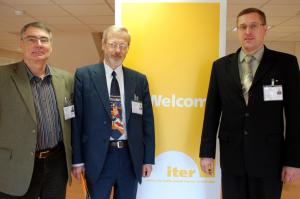Mission possible—delegation from Kazakhstan visits Cadarache
"Bigger," Pavel Beklemishev mumbles as Norbert Holtkamp is in the middle of giving a status report of the ITER Project. Talking about the scope of the international collaboration, ITER Principal Deputy Director-General Holtkamp has interrupted his presentation for a second to point out Kazakhstan on the world map and to describe the contour with a laser pointer. But for the director of the Byelkamit Group LLP, the head of the Kazakh delegation, Holtkamp is too restrained in describing the size of his country: "It is bigger, much bigger!"
And, yes, Kazakhstan is big indeed. The country that is bordered by Russia, Kyrgyzstan, Turkmenistan, Uzbekistan and China—and to a significant degree by the Caspian Sea—covers a territory equivalent to the whole of Western Europe. It is ranked as the ninth largest country in the world as well as the world's largest landlocked country; its population is 15.4 million. Kazakhstan declared itself an independent country on 16 December 1991, the last Soviet republic to do so.
And Kazakhstan has vast mineral resources. It has the second largest uranium, chromium, lead, and zinc reserves; the third largest manganese reserves; the fifth largest copper reserves; and ranks in the top ten for coal, iron, and gold. It is also an exporter of diamonds. Perhaps most significant for the economic development of the country, Kazakhstan also currently has the 11th largest proven reserves of both oil and natural gas.
Then why is Kazakhstan interested to join the ITER Project? "Because we need to think about our future," says Sergey Zhdanov, leading researcher at the Nuclear Physics Institute of the National Nuclear Center. "Although we are rich in regards to natural resources, we do not have an unlimited amount of oil or gas."
Kazakhstan at the moment relies completely on its vast oil, gas and coal reservoirs. Until now the country has no nuclear power station, although the country is the world's third biggest seller for uranium. "By 2015 we have the ambition to become number one," says Zhdanov. "But," he adds, "besides providing the raw material, we also want to become capable of the nuclear technology itself." In cooperation with Japan, Kazakhstan is going to build a helium cooled fission reactor in Kurchatov city (former USSR Nuclear Test Site).
And from fission to fusion—together with the Russian institutes Kurchatov and Efremov, Kazakhstan is currently working on a new tokamak for plasma-facing material testing: the Kazakhstani Tokamak for Material testing (KTM). Its construction in Kurchatov city was completed in 2007, and start-up of the complex is scheduled for 2010.
The technological and—in the long run—economic benefits from fusion technology is what the delegation from Kazakhstan is interested in. "We want to underline that this is a private mission," says Leonid Solovyov, a former rocket engineer and now technical director of BYELKAMIT JSC JV, who has a vast experience on ASME codes, ISO-9001, tanks, steel structure and nuclear codes. "And we are very confident with what we discussed so far," says Shopovalov, Deputy Director General of the Petropavlovsk heavy machine building plant. The delegation will be in Cadarache for another week discussing with the members of the Organization's departments how a cooperation or even a partnership between ITER and Kazakhstan could be launched at this stage of the project.


